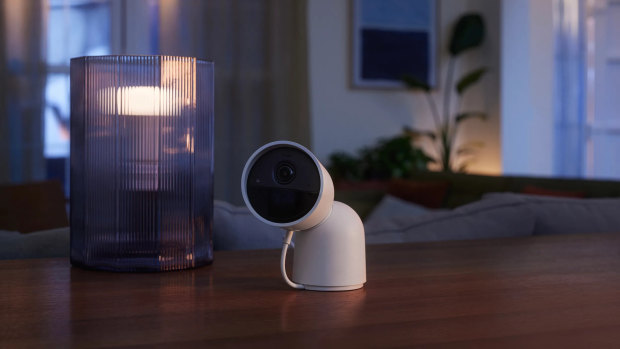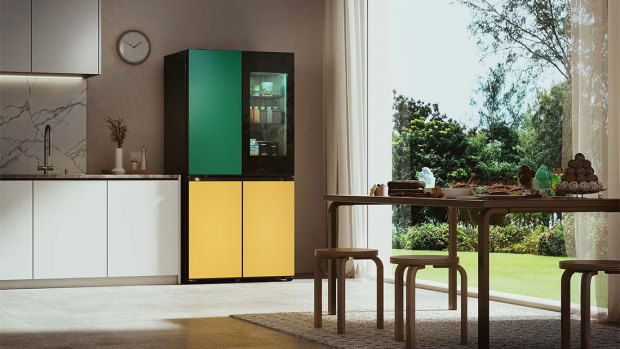From robot helpers to smart home sensors, all the latest connected tech was present last week at IFA, the world’s largest consumer electronics show in Berlin. We sat through the livestreams and pored through the press releases, and here are some of the smartest and weirdest innovations potentially coming soon to a home near you.
Smart home tech is everywhere
Phillips Hue introduced a new range of security gadgets, which could be appealing if you already have one of its bridge devices to power your smart lights. Its Secure cameras come in both battery and wired options, and feature encrypted video with no cloud processing.
There’s even a floodlight option that uses the brand’s familiar colour smart lighting, and a range of contact sensors so you can add smarts to your doors and windows while you’re at it. With all that together, you could set it up to flash all your lights, sound an alarm and notify you if someone enters your house unexpectedly.

Turn on all your home’s lights to scare away intruders with the Hue Secure cameras.
Aqara, which is a known entity in home automation, showed off an interesting ceiling light with a large illuminated section in the middle and a second around the edges. The idea is that you could set the outer ring to change in response to what’s happening in your home; for example, it could glow red when your front door is open. Or you could just use it for cool gradient colour effects.
IFA’s history is in home appliances, and that’s apparent from a glance at the whitegoods that Samsung and LG brought to the show. But of course, this is 2023, so they have to be smart whitegoods. Both companies unveiled new AI-powered washer-dryer combos that to my eyes may have been the same machine, and made a big deal of connectivity with mobile apps, so you can keep an eye on the washing from afar, or even download new cycle configurations.
Samsung took things in an unexpected direction with the launch of a new food-focused app, which is a recipe repository that can also use AI for things like converting recipes to be vegan-friendly. But of course, it also connects with smart ovens and fridges, so you never have to check manually if you have onions or bother with troublesome temperature knobs.
Not to be outdone, LG was showing off its latest line of MoodUp fridges, featuring door panels that are covered in LEDs so you can change their colour on a whim, or have them dance and flash in time with music.

MoodUp fridges were launched earlier this year, but light-up appliances is too good an idea not to iterate on.
The two companies also said jointly that from some time next year their respective smart home apps — ThinQ and SmartThings — will be able to control each other’s devices, which should be welcome news for anyone who’s mixed and matched.
Screens and entertainment
Keeping with the theme of inter-ecosystem love fests, JBL unveiled Authentics, a range of very handsome smart speakers that — for the first time — can run Amazon Alexa and Google Assistant at the same time. In practice that might not be all that useful for most people, but thankfully it’s not the only trick the devices have up their sleeves. Starting at $500, the speakers’ looks are inspired by 1970s tech and the highest-end version supports Dolby Atmos spatial sound.
Plenty of standard TVs made an appearance, including Samsung’s massive 98-inch Neo-QLED 8K TV, and its first-ever 89-inch Micro LED TV. Meanwhile, Hisense was out with its ultra-wide 200-inch set, which is actually two 4K short-throw projectors that blend their images together side-by-side on your wall. Another eye-catching unit was the Thomson Scenium transparent OLED, which is completely see-through when off.

This poor guy is going home with a StanbyME full of sand.
LG loves a strange TV concept, like its battery-powered StanbyME that rolls around your house on a stick with wheels. Where do you go from there?
At IFA, the company was showing off the StanbyME Go, a sturdy briefcase which can be opened to reveal a rotating 27-inch HD touchscreen TV with a four-channel sound system. It can run off battery for three hours, supports Dolby Vision and Atmos, has apps built in and can display content from phones or over HDMI. Australian launch details have not been announced, but it goes for $US1000 ($1600) in the US.
For a display that’s a little less whimsical but still pretty unusual, Lenovo was showing off a 27-inch PC monitor that can display in standard 4K or be switched to full-HD 3D, without requiring the user to wear special glasses. The ThinkVision 27 3D is designed for graphical creatives who want to see their work from all angles, and will go for around $US3000 ($4700). The monitor should pair well with the company’s Legion 9i laptop, which was also at IFA and which has a full liquid cooling setup inside for ultimate graphical performance.

Honor has partnered with designers and artists from around the world to create its virtual bags.
And finally in the unusual screen category, Honor made headlines with its fabulous smartphone concept dubbed the V Purse. It’s a folding phone sporting an always-on screen front and back when closed, unfurling out to a big square tablet. But the twist is a hook system that lets you attach a range of different straps, so the phone can be held like a purse or worn like a bag.
There is even a range of matching animated wallpapers that make the phone look like a bag, complete with jangling adornments. This isn’t a commercial product yet, but I kind of hope it becomes one.
And, of course, robots
Loading
Cleaning robots were heavily represented at the show this year. Units that both mop and vacuum — while also cleaning themselves and emptying dirt into their own waste bins — are more or less the baseline now, so manufacturers are having to push things further.
Dreame came out swinging with the DreameBot L20 Ultra, a premium model with everything its high-end competitors have, plus the unique ability to stretch out its little mop pads to the side and mop in corners. An Australian price hasn’t been announced but in the US, it goes for $US1500 ($2400).
SwitchBot, which doesn’t have much of a presence in Australia outside of online stores, showed off its S10 robot that hooks into your home’s plumbing to fill up on clean water and drain out dirty. You can install it by hooking its battery-powered pump up to pipes in your laundry, under your sink or at your toilet. The robot charges the pump when it visits to take water. And since it can raise and dry its mop pads, that means theoretically the only thing you need to do is change the vac bag inside its charging base every couple of months.
It can even carry water to fill up the Switchbot humidifier. It will be $US1200 ($1890) when it releases but somewhat concerningly, it’s headed for a Kickstarter campaign first, starting next month.
Ecovacs unveiled its latest vaccing and mopping design, the small and square Deebot X2 Omni, which will be sold in Australia for $2500. It looks to top the T20 Omni in every category, including suction power and mop pad lift, with Ecovacs opting for a strange measure of value by saying the X2 has more than 100 patents.
The company also showed off its lawn-mowing GOAT G1 robot, which will be $3000 in Australia. It promises a quick setup process involving wireless beacons for boundary-setting rather than physical wires, intelligent path-planning and obstacle avoidance. Ecovacs said it can mow a 600-square-metre lawn in a single day, and you can also use it as a roving security camera with its online camera.
iRobot wasn’t officially at IFA, but it happened to reveal new robots at the same time. The Roomba Combo i5+ is $1150 in Australia, giving you mopping and self-emptying for much less than the high-end $2200 j7+. But it’s also less smart. The i5+ doesn’t detect obstacles or differentiate between carpet and hard floors; it’s up to you to insert one of two different bins — vacuum only or vac and mop — before you send it off.
Get news and reviews on technology, gadgets and gaming in our Technology newsletter every Friday. Sign up here.
Most Viewed in Technology
Loading


